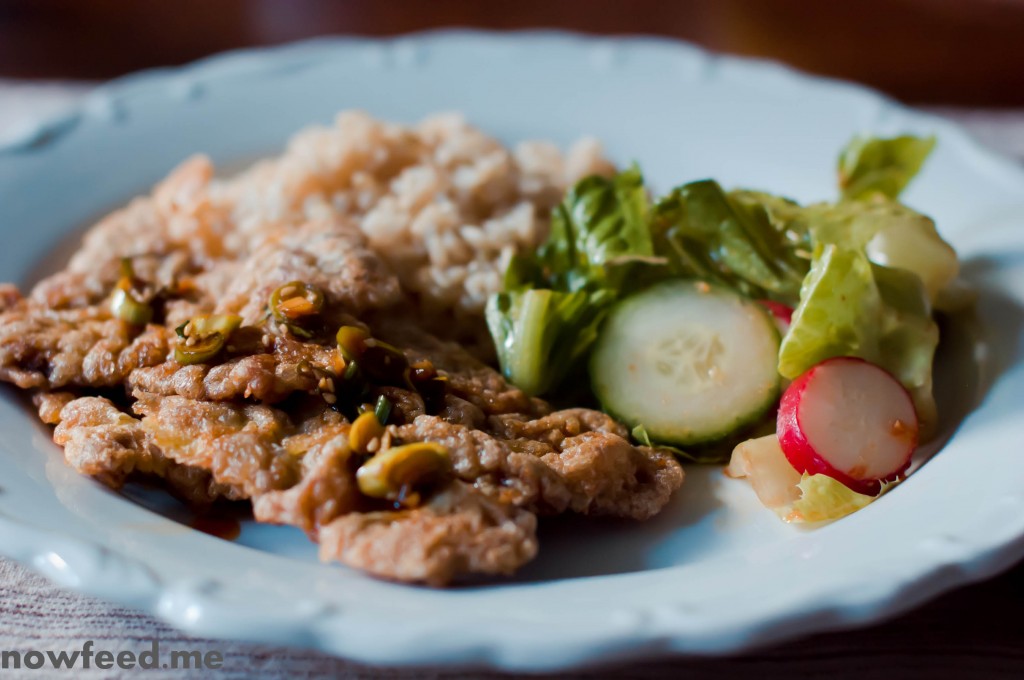Meat jun is a “Korean” food I discovered while living in Hawaii. It’s basically thin slices of beef that are marinated, coated in flour and egg, and fried. It is usually served with a soy sauce based dip and/or a gochujang-based hot sauce, rice, and various vegetable sides (banchan). Any time I went to the Ala Moana food court or stopped by a Yummy’s I would almost always fore go trying anything else just so I could order meat jun. The gold standard for meat jun however is Soon’s. I used to live right across the street from the place for a while but it became out of the way when I moved closer to the University area.
After I left Hawaii I always scanned the menu at Korean restaurants looking for meat jun, but I could never find it. Only later was I told by a Korean restaurant employee in Seattle that it is not actually Korean and seems to be a dish that was developed in Hawaii. That explains why many Korean people I asked did not know what it is.
The bottom line was that if I wanted to enjoy meat jun again before my next trip to Hawaii I was going to have to learn how to make it myself. In my typical fashion I scoured the web for recipes and picked bits of pieces of various recipes and came up with one which I thought I would like. Having made this several times now the result is a recipe which I have written down and come back to over and over again.
Ingredients
1 cup shoyu
3 Tbsp sesame seed oil
3-4 stalks green onion – finely chopped
2-3 cloves minced garlic
6 eggs – beaten
Flour – about 1 1/2 to 2 cups
Oil for frying (I use vegetable oil)
Preparation
Cut meat into thin slices if using a large cut, or use thin sliced beef (about 1/8 inch thick)
Place in a bowl – add shoyu, sesame seed oil, green onions, and garlic, mix well. Let sit for about 15 minutes. I like to do this a few hours before and let it marinate in the refrigerator.
Cooking
Dipping Sauce
My favored sauce:
1 cup shoyu
1/4 cup rice vinegar (Mirin)
1 stalk green onion, finely chopped
1-2 cloves garlic, minced or crushed
1/2 tsp toasted sesame seeds
My wife’s favored sauce:
Similar to the one above but add a tbsp of gochujang (Korean hot paste) and about a tsp of sesame oil, and no sesame seeds. We usually have both sauces at the table. I like spicy, but for some reason I just have to have my favored sauce with meat jun.
Gluten free variation:
- Replace the shoyu (soy sauce) with a gluten-free soy sauce or tamari. We use San-J brand but any brand you like will work. I find it a bit of a waste to marinate with San-J so if you can use a cheaper wheat-free brand for the marinade and use the “better” brand for the dipping sauce.
- Replace the flour with a gluten-free flour blend. We make one similar to the one found here.
I made the version for this recipe with gluten free ingredients only and it tasted the same as usual, so know that you won’t be missing out on anything at all.
Note:
Don’t buy meat which is sliced too thin. I always end up doing that then have to deal with the meat shredding apart. What’s too thin? Well for one if it’s cut for Sukiyaki (or hot pot) then it’s too thin. It should be about an 1/8 inch thick. The ones I get always end up being closer to a 1/16 inch thick – like a Sukiyaki cut – and they fall apart. Oh I still use them and they taste great, but it’s a bit inconvenient and harder to work with.









